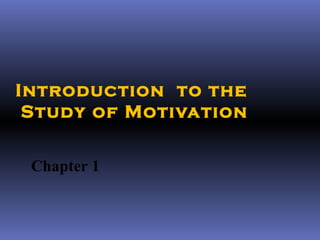
Ch01(1) 1
- 1. Introduction to the Study of Motivation Chapter 1
- 2. Motivation involves those processes that give behavior its energy and direction. Behavior is relatively strong, Intense, and persistent. Behavior is aimed toward achieving a particular purpose or goal .
- 3. Motivational Science Reality Representation (In all its complexity) Theory Hypothes (As created by es motivational psychologists) (As derived from the theory) Applications; Application Recommendations (How to support and enhance Data motivation and emotion in applied settings) (To test the adequacy of each hypothesis) Figure 1.1 illustrates the function and utility of a good theory.
- 4. Table 1.1 Motivational Reasons to Exercise Source of Why Exercise? Motivation Illustration Fun, enjoyment Intrinsic motivation Children exercise spontaneously—they run and jump and chase, and they do so simply for the sheer fun of it. Personal challengeFlow Athletes get “in the zone” when their sport optimally challenges their skills. Forced to do so External regulation Students exercise because their coach tells them to do so. Paid to do so Extrinsic Motivation A coach or instructor is paid to exercise and to help others exercise. Accomplish a goal Goal Runners see if they can run a mile in 6 minutes or less. Value its health Value People exercise to lose weight or to strengthen the benefits strengthen the heart. Inspired to do so Possible self People watch others exercising and becomes inspired to do the same. A standard of Achievement Snow skiers race to the bottom of the mountain trying to beat their excellence strivings previous best time. Satisfaction from Perceived competence As exercisers make progress, they feel more competent, more effective. a job well done An emotional kick Opponent process Vigorous jogging can produce a runner’s high (a rebound to the pain). Good mood Positive affect Beautiful weather can pick up exercisers’ moods and invigorate exercise spontaneously, as they skip along without knowing why. Alleviate guilt Introjection People exercise because they think that is what they should, ought to, or have to do to feel good about themselves. Relieve stress Personal control After a stressful day, people go to the silence depression gym, which they see as a structured, controllable environment. Hang out with friends Relatedness Exercise is often a social event, a time simply to enjoy hanging out with friends.
- 5. Two Perennial Questions Why does behavior What causes behavior? vary in its intensity? “Why does a person behave one way in a particular situation at one time yet “Why did she do that?” behave in a different way at another time?” “Why do people do what they do?” “What are the motivational differences among individuals, and how do such differences arise?”
- 6. Specific questions that constitute the core problems to be solved in motivation study
- 7. Needs The subject matter of motivation concerns those processes that give behavior Cognition its energy and direction. The four processes capable of giving behavior strength and purpose Emotions —its energy and direction— External events
- 8. Hierarchy of the Four Sources of Motivation Motivatio n Internal Motives External Motives Needs Cognition Emotions Figure 1. 2
- 9. Measuring Motivation: Expressions of Motivation Br ain & Behavior Engagemen Physiology Self- t Activation report s
- 11. Four Interrelated Aspects of engagement . Engagement Behavioral Emotional Cognitive Voice Engagement Engagement Engagement • Interest • Sophisticated • Offers Suggestions • Attention • Enjoyment Learning Strategies • Makes • Effort • Low Anger • Active Self- Contributions • Persistence • Low Frustration Regulation • Asks Questions Figure 1.3
- 12. Brain & Physiological Activity as Expressions of Motivation Brain activity Activation of brain structures such as the amygdala (fear) or prefrontal cortex (setting goals). Hormonal activity Chemicals in saliva or blood, such as cortisol (stress) or catecholamines (fight‑or‑flight reaction). Cardiovascular Contraction and relaxation of the heart and blood vessels activity (attractive incentives, difficult/challenging tasks). Ocular activity Eye behavior—pupil size (extent of mental activity), eye blinks (changing cognitive states), and eye movements (reflective thought). Electrodermal Electrical changes on the surface of the skin (expression of threat activity or stimulus significance). Skeletal activity Activity of the musculature, as with facial expressions (specific emotion) and bodily gestures (desire to leave). Table 1.3
- 13. Themes in the Study of Motivation Motivation includes both approach and avoidance tendencies.
- 14. Motives vary over time & Influence The Ongoing Stream of Behavior Motivation is a dynamic process-always changing, always rising and falling— rather than a discrete event or static condition. Table 1.4 How Motives Influence Behavior for a Student Sitting at a Desk Environmental Aroused Motive-Relevant Motive’s Urgency Event Motive Course of Action Attention-Getting Status Book Interest Read chapter. * Cola Thirst Drink beverage. * Familiar Voices Affiliation Talk with friends. *** Headache Pain avoidance Take aspirin. ***** Lack Of Sleep Rest Lie down, nap. * Upcoming Achievement Practice skill. ** Competition Note: The number of asterisks in column 4 represents the intensity of the aroused motive. One asterisk denotes the lowest intensity level, while five asterisks denote the highest intensity level.
- 15. Figure 1.4 Stream Of Behavior And The Changes In The Strength Of Its Underlying Motives
- 16. Framework To Understand The Study Of Motivation Energizing & Sense of Directing Antecedent Motive “Wanting to” • Behavior Conditions Status Urge to • Engagement Approach vs. • Physiology Avoid • Self-Report Needs Cognitions Emotions Figure 1.5
- 17. Using Motivational Theories to Solve Practical Problems Practical Given What I know About Proposed Solution/ Problem Human Motivation & Emotion Intervention, if any *Student dropout *Theories *Do I have a strong reason to believe that my proposed *Mediocre *Empirical findings intervention will produce positive benefits? Performance *Practical experience *Do no harm
